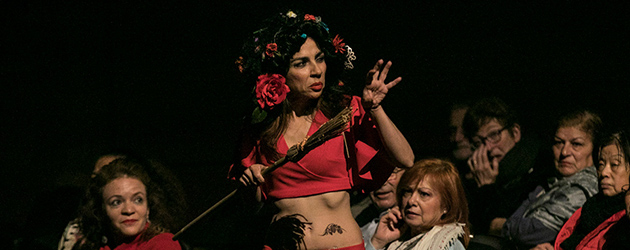Text: EStela Zatania
Photos Ana Palma
Isabel Bayón «Dju dju»
Friday, March 9th, 2018. 9:00pm. Teatro Villamarta. Jerez de la Frontera
Everyone warned me: “You’re going to see Dju Dju?…you!…that show isn’t for you”. True enough, it’s more normal to see me talking about cantes, guitar variations or dance steps, but being open-minded, curiosity got the better of me and I took on the challenge.
So let me tell you conventional flamenco fans who normally wouldn’t know how to deal with this show, or might offer resistance, what the experience was like. The first thing you have to do is lose the idea that you’re going to sniff out flamenco, no matter what it takes. Flamenco is a concept, a feeling, and the person who attends this work to see if soleá no. 5 of Juaniquí, or the siguiriya de cambio of Manuel Molina are adequately interpreted, well, you’re not going to be satisfied. Not because of a lack of flamenco singing – in fact the singer interpreted among other things, an impeccable siguiriya of Juanichi, Periñaca version; this is not a fictitious singer. But if you’re looking for a conventional recital, better to stay home, order something from JustEat, put on your favorite episode of Rito y Geografía del Cante (mine is the one with Macanita as a little girl), and enjoy.
However, the alternative I recommend, is that you put aside fixed ideas, and go to see this show, because you’re going to have a good time. It occurs to me that the easiest way to describe “Dju Dju” is through comparisons:
1. Alice in Wonderland, the Mad Hatter’s Tea Party.
Nothing is what it seems, and everything is possible. Even a little Christmas tree who wants to party, a stuffed toy cat that crosses the stage now and then without anyone taking notice and someone wearing the mask of “The Scream” by Munch who arrives with scissors to cut the strings of the guitar, one by one.
2. “Six Characters in Search of an Author” by Luigi Pirandello.
In Dju Dju we have six characters, well-versed in flamenco, who carry out various, apparently illogical or unconventional actions, just as in Pirandello’s ground-breaking existential play. The keyboardist, Alejandro Rojas-Marcos, wears a white bathrobe and sings English Christmas carols, singer Alejandro Villaescusa, looks like a golf-player from the fifties, two dancers, Alicia Márquez and Nieves Casablanca, of extremely different heights, seem to have escaped from someone’s bad dream and guitarist Jesús Torres looks suspiciously like Jesus Christ.
3. Di Chirico’s metaphysical painting.
Places you see for the first time, and yet you recognize them. Quotidian objects presented surrealistically and which you don’t quite trust, such as when Isabel appears to give birth to a Spanish shawl.
4. “The Twilight Zone”, popular television show of the sixties.
In one episode everything appears “normal”, but small incongruences reveal that the main character is not in the usual place. Like when Bayón dances with her head tilted to one side so the hat that’s covering her ear doesn’t fall, or the dancers who drag themselves across the stage seated uncomfortably small children’s chairs.
You can detect the hand of Israel Galván. In fact, both hands…and feet, torso, head… Especially the head, because none other would be capable of organizing this smorgasbord of elements.
The biggest surprise of all is Isabel Bayón’s expansive personality. She had previously always hidden her emotions in a cold sea of impeccable technique. In this work, she allows us to see the complete person with the associated emotions, with no fear or complexes upon expressing her fears and complexes, which is what the libretto defines as the motif of this work.
Maybe it’s not flamenco. Or maybe it is. What is quite clear is that if flamenco didn’t exist, this show wouldn’t exist either.
At midnight, at the Sala Compañía, Cádiz dancer Juan Ogalla, with his work “Bailar para Contarlo”, brought us back to Earth where we were able to enjoy his farruca (lots of farruca in the Festival this year) with Gardel’s famous tango “Volver”, in addition to alegrías and siguiriyas, among other pieces; a reflection on loneliness and nostalgia. A fabulous trio of singers, Emilio Florido, Miguel Rosendo and Manuel Gago, and the always interesting guitarist Eugenio Iglesias, rounded out the show.
Video:
